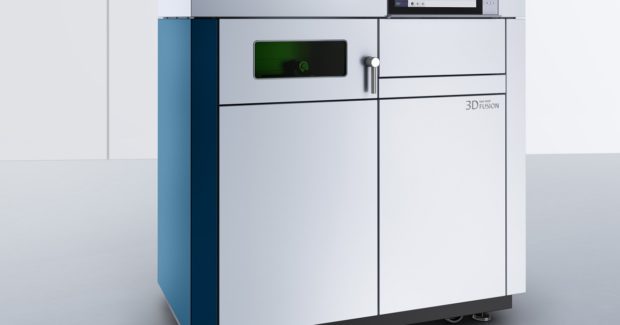Quick and Flexible 3D Printing of Complex Metal Parts
A perfect fit for job shops, medical or dental applications, or for research and development work, the TruPrint 1000 laser metal fusion printer from TRUMPF can generate complex parts that are a maximum of 100 mm diameter and 100 mm tall.
Posted: February 21, 2017
With the TruPrint 1000 laser metal fusion (LMF) printer and new developments in laser metal deposition (LMD), TRUMPF Inc. (Farmington, CT) provides all of the pertinent laser technologies for industrial 3D printing: the laser beam source, machine, powder, services and application consulting – all from a single source. The TruPrint 1000 uses a laser and metallic powder to build any desired component, based on data supplied directly by a CAD program. LMF systems create the component, layer by layer, from metal powders with grain sizes as small as 20 micron. This technology is ideal for parts that are complex in their geometry, such as those with internal channels and hollow spaces, and for manufacturing individual parts or short production runs economically.
The compact TruPrint 1000 is a perfect fit for job shops, medical or dental customers, or for research and development environments. It can generate parts that are a maximum of 100 mm diameter and 100 mm tall. The user interface with touch screen control steps the operator intuitively through the individual phases of the process. All the components, including the laser, optics, process enclosure, filter unit and control cabinet, are integrated into the compact housing of the TruPrint 1000. The supply cylinder, construction chamber and the overflow receiver are all aligned inside the enclosure. The supply cylinder contains the stainless steel, aluminum or any weldable material in powdered form. During the build, a layer of metal powder is applied to a substrate plate and then a 200 W laser is used to fuse the cross section of the geometry to the plate. After the exposure the plate is lowered and the next layer of powder is applied. This procedure is repeated until the part is finished. The entire process takes place inside the enclosure, blanketed by protective gas, and at an oxygen content of 0.1 percent for maximum part quality.
https://youtu.be/pWXWjaY4hXI
TRUMPF continues to optimize their LMD technology, which is ideal for adding volume and structures/ features to existing parts. In LMD systems, the laser forms a melt pool on the surface of a component and fuses the powder – applied simultaneously and coaxially – to create the desired shape. Applying multiple layers enables the user to expand the form in any direction. With the ability to add material at rates as great as 500 cu cm per hour, this process can be more economical than conventional manufacture. In addition, complex structures can be added to existing parts, allowing for the design of communized base structures that have features and strength added where needed. Based on the specifics of the application, fabricators can choose either the large TruLaser Cell 7040 or the more compact TruLaser Cell 3000 with the new LMD package.
TRUMPF Inc., Farmington Industrial Park, 111 Hyde Road, Farmington, CT 06032, 860-255-6000, www.us.trumpf.com.















